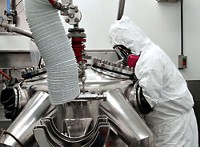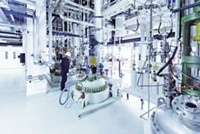Advertisement
Grab your lab coat. Let's get started
Welcome!
Welcome!
Create an account below to get 6 C&EN articles per month, receive newsletters and more - all free.
It seems this is your first time logging in online. Please enter the following information to continue.
As an ACS member you automatically get access to this site. All we need is few more details to create your reading experience.
Not you? Sign in with a different account.
Not you? Sign in with a different account.
ERROR 1
ERROR 1
ERROR 2
ERROR 2
ERROR 2
ERROR 2
ERROR 2
Password and Confirm password must match.
If you have an ACS member number, please enter it here so we can link this account to your membership. (optional)
ERROR 2
ACS values your privacy. By submitting your information, you are gaining access to C&EN and subscribing to our weekly newsletter. We use the information you provide to make your reading experience better, and we will never sell your data to third party members.
Business
Fine Chemicals: Optimism Prevails Over Uncertainty
by Rick Mullin
January 14, 2013
| A version of this story appeared in
Volume 91, Issue 2

The fine chemicals sector is showing strength going into 2013. Manufacturers of active pharmaceutical ingredients are optimistic about the year ahead. Agricultural chemicals are on track for another good year, and some industrial fine chemicals manufacturers, especially electronics industry suppliers, see a particularly strong 2013.
There is, however, an air of wait and see regarding investments in the sector. That is due to the volatile regulatory and tax landscape in the U.S. at year’s end. “We had a strong, but not a record-breaking, year,” says Lawrence D. Sloan, CEO of the Society of Chemical Manufacturers & Affiliates, a trade association. “Members are doing reasonably well considering all the uncertainty.”
The society’s members, primarily small fine and specialty chemical companies, are concerned about changes in taxation, according to Sloan. He notes that many companies are “S corporations” according to the Internal Revenue Service’s tax code, where income taxes are paid by individual shareholders rather than the corporation. With the bill passed earlier this month to avert the fiscal cliff, family-owned companies with profits of more than $450,000 will see their taxes increase. That could lead firms to put off hiring and making investments, Sloan says.
Although the fiscal cliff agreement extends R&D tax credits until the end of 2013, it also pushes off decisions on federal spending cuts, leaving manufacturers to guess which areas of the economy Congress and the President will protect or leave vulnerable to the budget knife, Sloan points out.
Still, company executives agree that 2013 will be an up year for fine chemicals. At Cambrex, CEO Steven M. Klosk says he is cautiously optimistic. In 2012 the company signed what may turn out to be the largest contract in its history. The deal, with a drug company, should bring in an estimated $20 million in revenue this year and continue into 2014. Business in the U.S. will likely be stronger than in Europe in 2013, Klosk says, although both regions should benefit from a return of outsourced manufacturing from China and India.
The return of work from Asia is a significant factor in a turnaround at Ampac Fine Chemicals, according to the company’s president, Aslam Malik. So is the demand for more complex chemistry. Ampac has been installing semiworks—facilities that produce quantities between pilot and full-scale commercial output—Malik says, to boost its business in high-value, low-volume chemicals.
David Ager, principal scientist at DSM, says his company is looking forward to a good year in pharmaceutical contract manufacturing, especially for products in early-stage development. “There is funding, and it’s full steam ahead,” he says.
MORE ON THIS STORY
- - World Chemical Outlook
- - Pharmaceuticals: Companies Will Focus On External Partnerships To Improve Productivity
- - U.S.: Domestic Manufacturing Slowdown Will Be Offset By Shale Gas Upside
- - Construction: The Action, Once Again, Is In Developing Countries
- - Europe: Economy And Chemical Industry Are Expected To Stagnate
- - Fine Chemicals: Optimism Prevails Over Uncertainty
- - Asia: Slowdown In China, Although Mild, Is Cause For Concern
- - Petrochemicals: The U.S. Will See A Boom As Europe And Asia Struggle
- - Cleantech: New Funding Will Be Scarce, But Scale-Up Plans Continue
- - Specialties: Growth To Be Fueled By Autos, Electronics
- - Canada: After A So-So 2012, Chemical Firms Prepare For A Brighter Future
- - Instrumentation: Firms Plan For The Long Term Amid Short-Term Uncertainties
- - Middle East: After Years Of Growth, A Profits Squeeze Lies Ahead
- - Advanced Materials: Carbon Fiber, 3-D Printing, Graphene To Make Inroads
- - Latin America: Policymakers, Industry Seek To Boost Competition




Join the conversation
Contact the reporter
Submit a Letter to the Editor for publication
Engage with us on Twitter